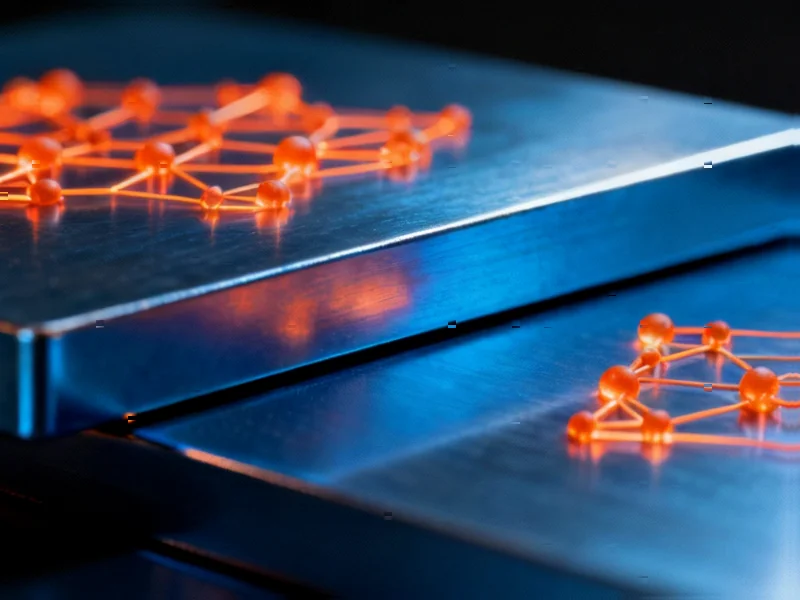The Quest for Superior Superalloys
In the demanding world of high-temperature materials science, researchers are increasingly turning to artificial intelligence to accelerate the development of next-generation superalloys. A groundbreaking study published in npj Computational Materials demonstrates how machine learning can simultaneously optimize two critical characteristics of γ’-strengthened cobalt-based superalloys—the γ’ phase coarsening rate (K) and volume fraction (V). These parameters directly impact the alloy’s high-temperature stability and mechanical strength, making them crucial for applications in aerospace, power generation, and industrial turbines.
Table of Contents
- The Quest for Superior Superalloys
- Building the Foundation: Data Collection and Augmentation
- Machine Learning Model Selection and Performance
- The Data Augmentation Breakthrough
- Interpretable AI: Understanding What Drives Performance
- From Prediction to Practical Application
- Industrial Implications and Future Directions
Building the Foundation: Data Collection and Augmentation
The research team began by compiling extensive experimental datasets from published literature, gathering 132 samples for γ’ phase coarsening rate and 615 samples for γ’ phase volume fraction. Recognizing the limitations of these datasets, particularly for the long-tailed distribution of K values, the researchers employed sophisticated multi-fidelity data augmentation techniques. They integrated phase diagram calculations with two advanced generative approaches: Markov Chain Monte Carlo (MCMC) using the No-U-Turn Sampler and Wasserstein Generative Adversarial Network with Gradient Penalty (WGAN-GP).
This innovative approach generated 1,000 synthetic samples using each method, with validation through Thermo-Calc software using established thermodynamic and mobility databases. After careful filtering and temperature optimization, the team obtained 876 valid samples from MCMC generation and 717 from WGAN-GP, significantly expanding the training data available for machine learning models.
Machine Learning Model Selection and Performance
The researchers evaluated four ensemble learning algorithms—Random Forest (RF), Gradient Boosted Decision Trees (GBDT), AdaBoost, and XGBoost—for predicting both target parameters. For predicting the coarsening rate constant K, input features included ten alloying elements (Co, Al, W, Ta, Ti, Nb, Ni, Cr, V, Mo) plus aging temperature. For volume fraction V prediction, aging time was added as an additional kinetic parameter., according to industry reports
XGBoost emerged as the top performer for both prediction tasks, though with notably different success rates. For K prediction, cross-validation yielded an R² of 0.593 ± 0.221, indicating moderate predictive capability. The model showed reasonable accuracy in the low-K region (0-200 nm·s) but struggled with higher values where data was sparse. In contrast, V prediction achieved remarkable accuracy with an R² of 0.864 ± 0.043, demonstrating the model’s effectiveness in capturing the compositional, thermal, and temporal dependencies governing volume fraction.
The Data Augmentation Breakthrough
The most significant improvement came from integrating synthetic data with experimental observations. When the researchers combined the original experimental data with all 876 MCMC-generated samples, the model’s predictive accuracy for K skyrocketed to an R² of 0.947 ± 0.018. The WGAN-GP approach, while achieving a slightly lower R² of 0.746 ± 0.148, produced substantially better error metrics with MAE and RMSE reductions to 13.631 ± 5.346 nm·s⁻¹ and 42.263 ± 23.831 nm·s⁻¹ respectively.
This dramatic improvement highlights the critical importance of data quality and distribution in machine learning applications for materials science. The MCMC approach provided broader coverage of the feature space, while WGAN-GP generated data that more closely resembled the original experimental distribution, resulting in better error metrics despite a lower R² value.
Interpretable AI: Understanding What Drives Performance
Moving beyond black-box predictions, the researchers employed SHAP (SHapley Additive exPlanations) analysis to interpret the machine learning models. This approach quantified the contribution of individual alloying elements and processing parameters to both coarsening rate and volume fraction, while also revealing complex feature interactions. This interpretability component proved crucial for guiding the design of new alloy compositions with optimized microstructural characteristics.
From Prediction to Practical Application
Leveraging insights from the SHAP analysis, the team designed novel cobalt-based superalloy compositions that simultaneously achieved relatively low γ’ phase coarsening rates and high γ’ phase volume fractions. These compositions were subsequently validated through both computational phase diagram analysis and experimental evaluation, confirming the machine learning models’ practical utility in materials design.
The successful identification of optimal composition sets that meet multiple performance criteria demonstrates the transformative potential of machine learning in accelerating materials discovery and optimization. This approach significantly reduces the traditional trial-and-error methodology that has long characterized alloy development., as comprehensive coverage
Industrial Implications and Future Directions
This research represents a significant advancement in computational materials design with immediate practical applications. The ability to accurately predict both kinetic (coarsening rate) and thermodynamic (volume fraction) parameters enables more efficient development of superalloys for extreme environments. Industries relying on high-temperature materials, particularly aerospace and energy sectors, stand to benefit from reduced development cycles and improved material performance.
Future work will likely focus on expanding the approach to additional material properties and exploring transfer learning between different alloy systems. As machine learning methodologies continue to evolve and datasets grow, we can anticipate even more sophisticated materials design capabilities emerging in the coming years, potentially revolutionizing how we develop advanced materials for critical industrial applications.
Related Articles You May Find Interesting
- Redwood Materials Secures $350M Funding to Expand Grid Battery Production Amid A
- Molecular Threading Breakthrough Enables Precision Drug Delivery Systems
- Molecular Weaving Breakthrough Enables Energy-Efficient Heavy Water Production
- Generation Lab Secures $11M in Seed Funding Led by Accel to Pioneer Epigenetic L
- UK’s Hydrogen Strategy at Crossroads as Industry Demands Clear Ammonia Integrati
This article aggregates information from publicly available sources. All trademarks and copyrights belong to their respective owners.
Note: Featured image is for illustrative purposes only and does not represent any specific product, service, or entity mentioned in this article.



